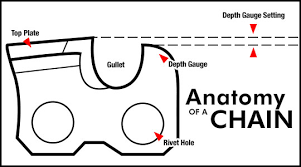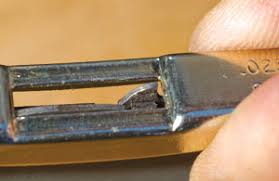In a nut shell it would make it very aggressive.
All dimensions and angles have to be the same left to right and all play a part in how the chain cuts.
Heres the file above the top of the tooth and the holder style I use.

The properly used sharpener with the proper size file will keep around 20 % of the file above the top plate and this sets the proper hook to the tooth. Cuts great and good filing intervals. Using the proper size file in the proper holder and follow the top plate and raker depths and the chain will cut great, long filing intervals and give you no issues.
Using a a larger file in a smaller file holder put the file lower than the norm and will make a razor edge, very sharp and very fine but easily damaged, but it will flat out cut. Nice fun chain that will cut like crazy if you have the power to pull it but will be really aggressive, yanking the saw around and throwing wood that isn't held down.
Using a smaller file in a in a larger file holder will put the file higher than the norm and make an edge closer to a sharp ax, will cut OKish and tough to damage cause there is thicker metal to the edge. Less easily damaged and longer file intervals but won't cut as quick. A trick I use in dirty wood or small pieces as it won't throw the wood and can take a bit of a beating. I also do this to others chains that are bad at stuffing the nose of the bar in the dirt when ground cutting and limbing.

Nice close up of the hook.
Now to the rakers and using a gauge. The raker depth gauge from Husky has 2 sides to it, a hard and soft side for the basic types of wood. These are different depths to the rakers below the top of the tooth. The hard side is a higher raker for hard wood and the soft side is a lower for soft wood. The raker depth sets how deep the tooth bites into the wood, the deeper it is the more power it takes to pull the chain through, the faster it cuts, the more aggressive it is along with thrown wood to kick back and push back. The less the raker depth......
The teeth on these saw teeth are actually tapered and as you sharpen the chain the top of the tooth is lower, which makes the raker depth less so you have to file it down to an even depth and angle.

The Husky gauge is a progressive gauge that sets the raker depth to the tooth it is attached to, not an average like a Oregon gauge that is set across 2 teeth. There are other brands of progressive gauges but it's what I use.
540 × 300 - mowersatjacks.com
400 × 400 - sherrilltree.com
I can't find a decent pic of it in use.
You pick the hard or soft side according to the wood your going to cut, take the end notch and put it up to the back of the tooth in front of the raker your working on, the raker to be filed will stick out the square hole with the tick out of it. The gauge is on a proper upward slope and all you do is grab the flat file and hit it till it quits cutting, more on to the next raker. It's that quick and easy.
This is an Oregon gauge across 2 teeth and the raker winds up flat, you have to put the angle on free hand. I'm not a fan of these but they work, I guess.....

300 × 195 - extremehowto.com
Follow what the manufacturer recommend for file size, angles.... and it will work just fine for you.
So you've done one of em now, go ahead and do the other 30+ of em, all the same top plate angle, tooth length, hook angle, depth gauge depth......and go chuck some chips!!


